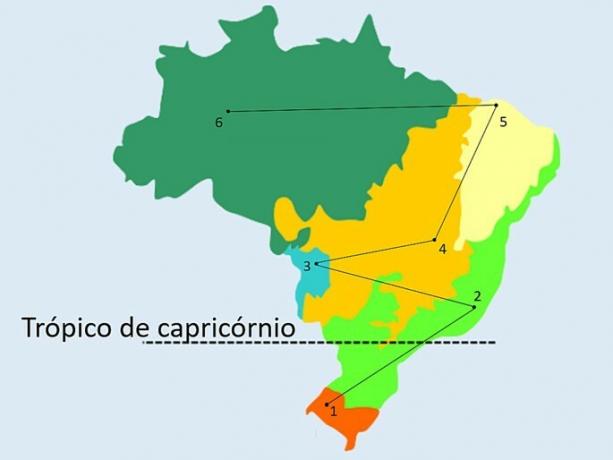A periodic function repeats itself along the x-axis. In the graph below we have the representation of a function of the type . Product A.
é:
The amplitude is the magnitude of the measurement between the equilibrium line (y = 0), and a crest (highest point) or valley (lowest point).
Thus, A = 2.
The period is the length in x of a complete wave, which on the graph is .
The coefficient of x can be obtained from the relationship:
The product between A and é:
The real function defined by has period 3
and image [-5,5]. The function law is
In the trigonometric function sin x or cos x, the parameters A and w modify their characteristics.
Determination of A
A is the amplitude and changes the image of the function, that is, the maximum and minimum points that the function will reach.
In the sinx and cos x functions, the range is [-1, 1]. Parameter A is an image amplifier or compressor, as we multiply the result of the function by it.
Since the image is [-5, 5], A must be 5, because: -1. 5 = -5 and 1. 5 = 5.
Determination of
is multiplying x, therefore, it modifies the function on the x axis. It compresses or stretches the function in an inversely proportional way. This means that it changes the period.
If it is greater than 1 it compresses, if it is less than 1 it stretches.
When multiplying by 1, the period is always 2, when multiplying by
, the period became 3
. Writing the proportion and solving the rule of three:
The function is:
f (x) = 5.sin (2/3.x)
A comet with an elliptical orbit passes close to Earth at regular intervals described by the function where t represents the interval between their appearances in tens of years. Suppose the last appearance of the comet was recorded in 1982. This comet will pass by Earth again in
We need to determine the period, time for a complete cycle. This is the time in tens of years for the comet to complete its orbit and return to Earth.
The period can be determined by the relationship:
Explaining T:
The value is the coefficient of t, that is, the number that multiplies t, which in the function given by the problem is
.
Considering and substituting the values in the formula, we have:
9.3 tens is equal to 93 years.
As the last appearance occurred in 1982, we have:
1982 + 93 = 2075
Conclusion
The comet will pass again in 2075.
(Enem 2021) A spring is released from the stretched position as shown in the figure. The figure on the right represents the graph of the position P (in cm) of mass m as a function of time t (in seconds) in a Cartesian coordinate system. This periodic movement is described by an expression of the type P(t) = ± A cos (ωt) or P(t) = ± A sin (ωt), where A >0 is the maximum displacement amplitude and ω is the frequency, which is related to the period T by the formula ω = 2π/T.
Consider the absence of any dissipative forces.
The algebraic expression that represents the positions P(t) of mass m, over time, on the graph, is
Analyzing the initial instant t = 0, we see that the position is -3. We will test this ordered pair (0, -3) in the two function options provided in the statement.
For
We have that sine of 0 is 0. This information is obtained from the trigonometric circle.
Thus, we would have:
This information is false, because at time 0 the position is -3. That is, P(0) = -3. Thus, we discard the options with the sine function.
Testing for the cosine function:
Once again, we know from the trig circle that the cosine of 0 is 1.
From the graph, we saw that the position at time 0 is -3, therefore, A = -3.
Combining this information, we have:
The period T is removed from the graph, it is the length between two peaks or two valleys, where T = .
The expression for frequency is provided by the statement, being:
The final answer is:
(Enem 2018) In 2014, the largest Ferris wheel in the world, the High Roller, was opened in Las Vegas. The figure represents a sketch of this Ferris wheel, in which point A represents one of its chairs:
From the indicated position, where the OA segment is parallel to the ground plane, the High Roller is rotated counterclockwise, around point O. Let t be the angle determined by the segment OA in relation to its initial position, and f be the function that describes the height of point A, in relation to the ground, as a function of t.
For t = 0 the position is 88.
cos(0) = 1
sin(0) = 0
Substituting these values, in option a, we have:
The maximum value occurs when the value of the denominator is the smallest possible.
The term 2 + cos (x) should be as small as possible. Thus, we must think about the smallest possible value that cos (x) can assume.
The cos (x) function varies between -1 and 1. Substituting the smallest value into the equation:
(UECE 2021) In the plane, with the usual Cartesian coordinate system, the intersection of the graphs of real functions of real variable f (x)=sin (x) and g (x)=cos (x) are, for each integer k, the points P(xk, yk). Then the possible values for yk are
We want to determine the intersection values of the sine and cosine functions which, as they are periodic, will repeat themselves.
The values of sine and cosine are the same for angles of 45° and 315°. With the help of a table of notable angles, for 45°, the sine and cosine values of 45° are .
For 315° these values are symmetric, that is, .
The correct option is the letter a: It is
.
ASTH, Rafael. Exercises on trigonometric functions with answers.All Matter, [n.d.]. Available in: https://www.todamateria.com.br/exercicios-sobre-funcoes-trigonometricas/. Access at:



